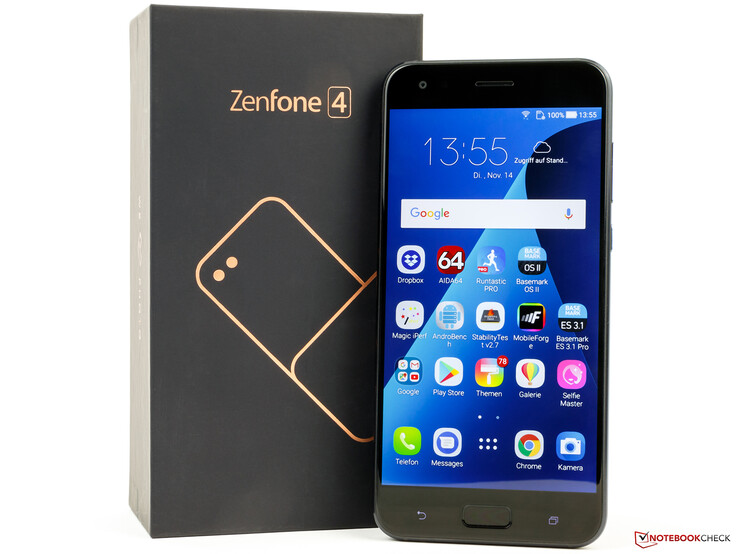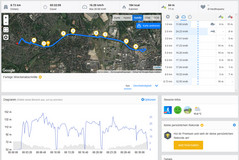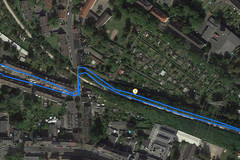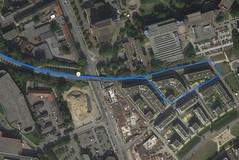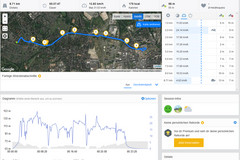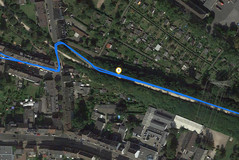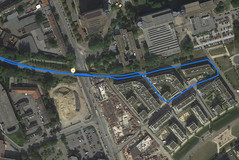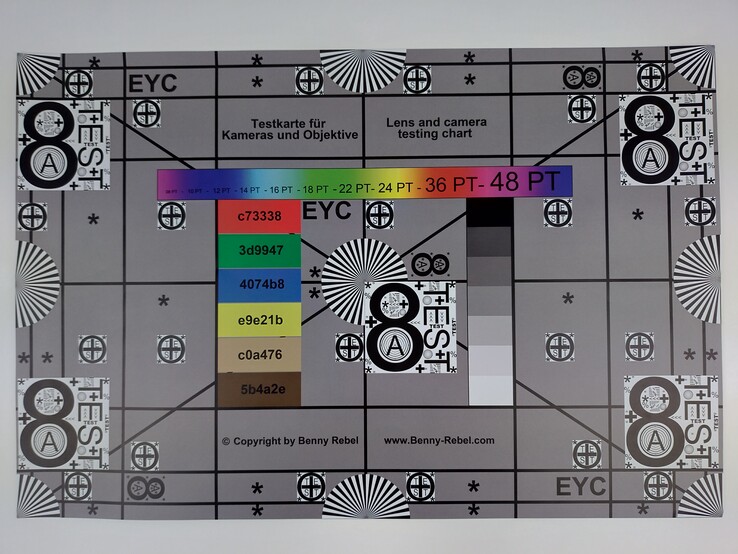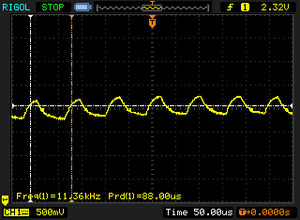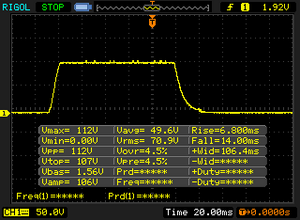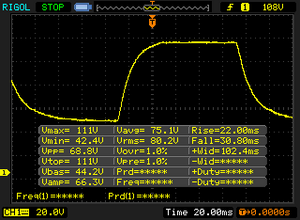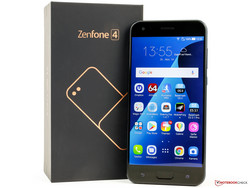Breve análisis del Smartphone Asus ZenFone 4 ZE554KL
Top 10 Análisis
» Top 10 Portátiles Multimedia
» Top 10 Portátiles de Juego
» Top 10 Portátiles de Juego ligeros
» Top 10 Portátiles Asequibles de Oficina/Empresa
» Top 10 Portátiles de Juego Ligeros
» Top 10 Portátiles de Oficina/Empresa Premium
» Top 10 Estaciones de Trabajo
» Top 10 Subportátiles
» Top 10 Ultrabooks
» Top 10 Convertibles
» Top 10 Tablets
» Top 10 Tablets Windows
» Top 10 Tablets de menos de 250 Euros
» Top 10 Phablets (>5.5")
» Top 10 Smartphones
» Top 10 Smartphones (≤5")
» Top 10 Smartphones de menos de 300 Euros
» Top 10 Smartphones de menos de 120 Euros
» Top 10 Portátiles de menos de 1000 Euros
» Top 10 Portátiles de menos de 500 Euros
» Top 10 Portátiles de menos de 300 Euros
» Los Mejores Displays de Portátiles Analizados por Notebookcheck
| Networking | |
| iperf3 transmit AX12 | |
| OnePlus 5 | |
| Huawei P10 | |
| Asus ZenFone 4 ZE554KL | |
| Nokia 8 | |
| BQ Aquaris X Pro | |
| Honor 9 | |
| Lenovo Moto Z2 Play | |
| iperf3 receive AX12 | |
| OnePlus 5 | |
| Asus ZenFone 4 ZE554KL | |
| Huawei P10 | |
| Honor 9 | |
| BQ Aquaris X Pro | |
| Nokia 8 | |
| Lenovo Moto Z2 Play | |
| |||||||||||||||||||||||||
iluminación: 93 %
Brillo con batería: 656 cd/m²
Contraste: 1640:1 (Negro: 0.4 cd/m²)
ΔE ColorChecker Calman: 5.3 | ∀{0.5-29.43 Ø4.78}
ΔE Greyscale Calman: 5.2 | ∀{0.09-98 Ø5}
Gamma: 2.22
CCT: 7905 K
| Asus ZenFone 4 ZE554KL IPS, 1920x1080, 5.5" | BQ Aquaris X Pro IPS, 1920x1080, 5.2" | Lenovo Moto Z2 Play AMOLED, 1920x1080, 5.5" | Honor 9 IPS/LTPS, 1920x1080, 5.2" | OnePlus 5 AMOLED, 1920x1080, 5.5" | Huawei P10 LTPS, 1920x1080, 5.1" | Nokia 8 IPS, 2560x1440, 5.3" | |
|---|---|---|---|---|---|---|---|
| Screen | -44% | -10% | 7% | 20% | -7% | -34% | |
| Brightness middle (cd/m²) | 656 | 458 -30% | 434 -34% | 550 -16% | 426 -35% | 547 -17% | 735 12% |
| Brightness (cd/m²) | 634 | 473 -25% | 404 -36% | 535 -16% | 431 -32% | 556 -12% | 707 12% |
| Brightness Distribution (%) | 93 | 88 -5% | 81 -13% | 92 -1% | 93 0% | 86 -8% | 92 -1% |
| Black Level * (cd/m²) | 0.4 | 0.51 -28% | 0.42 -5% | 0.43 -8% | 0.79 -98% | ||
| Contrast (:1) | 1640 | 898 -45% | 1310 -20% | 1272 -22% | 930 -43% | ||
| Colorchecker dE 2000 * | 5.3 | 7.1 -34% | 4.4 17% | 3.3 38% | 1.6 70% | 4.8 9% | 6.7 -26% |
| Colorchecker dE 2000 max. * | 7.8 | 14.5 -86% | 8.6 -10% | 4.5 42% | 4.1 47% | 8.8 -13% | 12.9 -65% |
| Greyscale dE 2000 * | 5.2 | 10.5 -102% | 4.2 19% | 3.6 31% | 1.7 67% | 4.5 13% | 8.3 -60% |
| Gamma | 2.22 99% | 2.28 96% | 2.24 98% | 2.38 92% | 2.25 98% | 2.39 92% | 2.24 98% |
| CCT | 7905 82% | 8951 73% | 7343 89% | 7226 90% | 6329 103% | 7194 90% | 8906 73% |
* ... más pequeño es mejor
Parpadeo de Pantalla / PWM (Pulse-Width Modulation)
| Parpadeo de Pantalla / PWM detectado | 11360 Hz | ≤ 35 % de brillo | |
La retroiluminación del display parpadea a 11360 Hz (seguramente usa PWM - Pulse-Width Modulation) a un brillo del 35 % e inferior. Sobre este nivel de brillo no debería darse parpadeo / PWM. La frecuencia de 11360 Hz es bastante alta, por lo que la mayoría de gente sensible al parpadeo no debería ver parpadeo o tener fatiga visual. Comparación: 53 % de todos los dispositivos testados no usaron PWM para atenuar el display. Si se usó, medimos una media de 8101 (mínimo: 5 - máxmo: 343500) Hz. | |||
Tiempos de respuesta del display
| ↔ Tiempo de respuesta de Negro a Blanco | ||
|---|---|---|
| 20.8 ms ... subida ↗ y bajada ↘ combinada | ↗ 6.8 ms subida | |
| ↘ 14 ms bajada | ||
| La pantalla mostró buenos tiempos de respuesta en nuestros tests pero podría ser demasiado lenta para los jugones competitivos. En comparación, todos los dispositivos de prueba van de ##min### (mínimo) a 240 (máximo) ms. » 45 % de todos los dispositivos son mejores. Eso quiere decir que el tiempo de respuesta es similar al dispositivo testado medio (20.2 ms). | ||
| ↔ Tiempo de respuesta 50% Gris a 80% Gris | ||
| 52.8 ms ... subida ↗ y bajada ↘ combinada | ↗ 22 ms subida | |
| ↘ 30.8 ms bajada | ||
| La pantalla mostró tiempos de respuesta lentos en nuestros tests y podría ser demasiado lenta para los jugones. En comparación, todos los dispositivos de prueba van de ##min### (mínimo) a 636 (máximo) ms. » 89 % de todos los dispositivos son mejores. Eso quiere decir que el tiempo de respuesta es peor que la media (31.6 ms) de todos los dispositivos testados. | ||
| AnTuTu v6 - Total Score (ordenar por valor) | |
| Asus ZenFone 4 ZE554KL | |
| BQ Aquaris X Pro | |
| Lenovo Moto Z2 Play | |
| Honor 9 | |
| OnePlus 5 | |
| Huawei P10 | |
| Nokia 8 | |
| PCMark for Android | |
| Work performance score (ordenar por valor) | |
| Asus ZenFone 4 ZE554KL | |
| BQ Aquaris X Pro | |
| Lenovo Moto Z2 Play | |
| Honor 9 | |
| OnePlus 5 | |
| Huawei P10 | |
| Nokia 8 | |
| Work 2.0 performance score (ordenar por valor) | |
| Asus ZenFone 4 ZE554KL | |
| BQ Aquaris X Pro | |
| Lenovo Moto Z2 Play | |
| Honor 9 | |
| OnePlus 5 | |
| Huawei P10 | |
| Nokia 8 | |
| Geekbench 4.4 | |
| 64 Bit Single-Core Score (ordenar por valor) | |
| Asus ZenFone 4 ZE554KL | |
| BQ Aquaris X Pro | |
| Lenovo Moto Z2 Play | |
| Honor 9 | |
| OnePlus 5 | |
| Huawei P10 | |
| Nokia 8 | |
| 64 Bit Multi-Core Score (ordenar por valor) | |
| Asus ZenFone 4 ZE554KL | |
| BQ Aquaris X Pro | |
| Lenovo Moto Z2 Play | |
| Honor 9 | |
| OnePlus 5 | |
| Huawei P10 | |
| Nokia 8 | |
| Compute RenderScript Score (ordenar por valor) | |
| Asus ZenFone 4 ZE554KL | |
| Lenovo Moto Z2 Play | |
| Honor 9 | |
| OnePlus 5 | |
| Huawei P10 | |
| GFXBench (DX / GLBenchmark) 2.7 | |
| T-Rex Onscreen (ordenar por valor) | |
| Asus ZenFone 4 ZE554KL | |
| BQ Aquaris X Pro | |
| Lenovo Moto Z2 Play | |
| Honor 9 | |
| OnePlus 5 | |
| Huawei P10 | |
| Nokia 8 | |
| 1920x1080 T-Rex Offscreen (ordenar por valor) | |
| Asus ZenFone 4 ZE554KL | |
| BQ Aquaris X Pro | |
| Lenovo Moto Z2 Play | |
| Honor 9 | |
| OnePlus 5 | |
| Huawei P10 | |
| Nokia 8 | |
| GFXBench 3.0 | |
| on screen Manhattan Onscreen OGL (ordenar por valor) | |
| Asus ZenFone 4 ZE554KL | |
| BQ Aquaris X Pro | |
| Lenovo Moto Z2 Play | |
| Honor 9 | |
| OnePlus 5 | |
| Huawei P10 | |
| Nokia 8 | |
| 1920x1080 1080p Manhattan Offscreen (ordenar por valor) | |
| Asus ZenFone 4 ZE554KL | |
| BQ Aquaris X Pro | |
| Lenovo Moto Z2 Play | |
| Honor 9 | |
| OnePlus 5 | |
| Huawei P10 | |
| Nokia 8 | |
| GFXBench 3.1 | |
| on screen Manhattan ES 3.1 Onscreen (ordenar por valor) | |
| Asus ZenFone 4 ZE554KL | |
| BQ Aquaris X Pro | |
| Lenovo Moto Z2 Play | |
| Honor 9 | |
| OnePlus 5 | |
| Huawei P10 | |
| Nokia 8 | |
| 1920x1080 Manhattan ES 3.1 Offscreen (ordenar por valor) | |
| Asus ZenFone 4 ZE554KL | |
| BQ Aquaris X Pro | |
| Lenovo Moto Z2 Play | |
| Honor 9 | |
| OnePlus 5 | |
| Huawei P10 | |
| Nokia 8 | |
| GFXBench | |
| on screen Car Chase Onscreen (ordenar por valor) | |
| Asus ZenFone 4 ZE554KL | |
| BQ Aquaris X Pro | |
| Lenovo Moto Z2 Play | |
| Honor 9 | |
| OnePlus 5 | |
| Huawei P10 | |
| Nokia 8 | |
| 1920x1080 Car Chase Offscreen (ordenar por valor) | |
| Asus ZenFone 4 ZE554KL | |
| BQ Aquaris X Pro | |
| Lenovo Moto Z2 Play | |
| Honor 9 | |
| OnePlus 5 | |
| Huawei P10 | |
| Nokia 8 | |
| Lightmark - 1920x1080 1080p (ordenar por valor) | |
| Asus ZenFone 4 ZE554KL | |
| Huawei P10 | |
| Basemark X 1.1 | |
| Medium Quality (ordenar por valor) | |
| Huawei P10 | |
| High Quality (ordenar por valor) | |
| Huawei P10 | |
| Basemark ES 3.1 / Metal - offscreen Overall Score (ordenar por valor) | |
| Asus ZenFone 4 ZE554KL | |
| Huawei P10 | |
| Epic Citadel - Ultra High Quality (ordenar por valor) | |
| Huawei P10 | |
| JetStream 1.1 - Total Score | |
| OnePlus 5 (Chrome 59) | |
| Nokia 8 (Chrome 61.0.3163.98) | |
| Honor 9 (Chrome 59) | |
| Huawei P10 (Chrome 56) | |
| Lenovo Moto Z2 Play (Chrome 59) | |
| Asus ZenFone 4 ZE554KL (Chrome 62) | |
| BQ Aquaris X Pro (Chrome 59.0.3071.125) | |
| Octane V2 - Total Score | |
| OnePlus 5 (Chrome 59) | |
| Nokia 8 (Chrome 61.0.3163.98) | |
| Huawei P10 (Chrome 56) | |
| Honor 9 (Chrome 59) | |
| Lenovo Moto Z2 Play (Chrome 59) | |
| BQ Aquaris X Pro (Chrome 59.0.3071.125) | |
| Asus ZenFone 4 ZE554KL (Chrome 62) | |
| Mozilla Kraken 1.1 - Total | |
| Asus ZenFone 4 ZE554KL (Chrome 62) | |
| BQ Aquaris X Pro (Chrome 59.0.3071.125) | |
| Lenovo Moto Z2 Play (Chrome 59) | |
| Nokia 8 (Chrome 61.0.3163.98) | |
| Honor 9 (Chrome 59) | |
| Huawei P10 (Chrome 56) | |
| OnePlus 5 (Chrome 59) | |
| WebXPRT 2015 - Overall | |
| Nokia 8 (Chrome 61.0.3163.98) | |
| OnePlus 5 (Chrome 59) | |
| Huawei P10 (Chrome 56) | |
| Honor 9 (Chrome 59) | |
| Asus ZenFone 4 ZE554KL (Chrome 62) | |
| BQ Aquaris X Pro (Chrome 59.0.3071.125) | |
| Lenovo Moto Z2 Play (Chrome 59) | |
* ... más pequeño es mejor
| Asus ZenFone 4 ZE554KL | BQ Aquaris X Pro | Honor 9 | OnePlus 5 | Huawei P10 | Nokia 8 | Lenovo Moto Z2 Play | |
|---|---|---|---|---|---|---|---|
| AndroBench 3-5 | -10% | 41% | 105% | 352% | 51% | 70% | |
| Sequential Read 256KB (MB/s) | 287.4 | 270.5 -6% | 293 2% | 748 160% | 738 157% | 680 137% | 245.6 -15% |
| Sequential Write 256KB (MB/s) | 205.3 | 139.6 -32% | 204 -1% | 201.5 -2% | 189.8 -8% | 199.1 -3% | 137.5 -33% |
| Random Read 4KB (MB/s) | 68.6 | 37.97 -45% | 55.7 -19% | 141 106% | 168.4 145% | 145.7 112% | 38.2 -44% |
| Random Write 4KB (MB/s) | 7.59 | 12.07 59% | 32.7 331% | 19.3 154% | 152.3 1907% | 14.57 92% | 47.9 531% |
| Sequential Read 256KB SDCard (MB/s) | 86.9 ? | 78.7 ? -9% | 68 ? -22% | 54.2 ? -38% | 76.8 ? -12% | 79.7 ? -8% | |
| Sequential Write 256KB SDCard (MB/s) | 66.5 ? | 49.77 ? -25% | 34.64 ? -48% | 32.19 ? -52% | 51.7 ? -22% | 58.7 ? -12% |
| Asphalt 8: Airborne | |||
| Configuraciones | Valor | ||
| high | 30 fps | ||
| very low | 30 fps | ||
| Real Racing 3 | |||
| Configuraciones | Valor | ||
| high | 32 fps | ||
| Temple Run 2 | |||
| Configuraciones | Valor | ||
| default | 58 fps | ||
| Dead Trigger 2 | |||
| Configuraciones | Valor | ||
| high | 30 fps | ||
(+) La temperatura máxima en la parte superior es de 35.3 °C / 96 F, frente a la media de 35.2 °C / 95 F, que oscila entre 21.9 y 247 °C para la clase Smartphone.
(+) El fondo se calienta hasta un máximo de 31.7 °C / 89 F, frente a la media de 34 °C / 93 F
(+) En reposo, la temperatura media de la parte superior es de 29.6 °C / 85# F, frente a la media del dispositivo de 32.9 °C / 91 F.
Asus ZenFone 4 ZE554KL análisis de audio
(+) | los altavoces pueden reproducir a un volumen relativamente alto (#82.2 dB)
Graves 100 - 315 Hz
(-) | casi sin bajos - de media 28.3% inferior a la mediana
(±) | la linealidad de los graves es media (8.1% delta a frecuencia anterior)
Medios 400 - 2000 Hz
(+) | medios equilibrados - a sólo 3.7% de la mediana
(+) | los medios son lineales (6.5% delta a la frecuencia anterior)
Altos 2 - 16 kHz
(+) | máximos equilibrados - a sólo 3.9% de la mediana
(+) | los máximos son lineales (5.4% delta a la frecuencia anterior)
Total 100 - 16.000 Hz
(±) | la linealidad del sonido global es media (21.7% de diferencia con la mediana)
En comparación con la misma clase
» 43% de todos los dispositivos probados de esta clase eran mejores, 8% similares, 49% peores
» El mejor tuvo un delta de 11%, la media fue 35%, el peor fue ###max##%
En comparación con todos los dispositivos probados
» 61% de todos los dispositivos probados eran mejores, 7% similares, 32% peores
» El mejor tuvo un delta de 4%, la media fue 24%, el peor fue ###max##%
Lenovo Moto Z2 Play análisis de audio
(+) | los altavoces pueden reproducir a un volumen relativamente alto (#86.8 dB)
Graves 100 - 315 Hz
(-) | casi sin bajos - de media 30.9% inferior a la mediana
(±) | la linealidad de los graves es media (9.6% delta a frecuencia anterior)
Medios 400 - 2000 Hz
(+) | medios equilibrados - a sólo 4.9% de la mediana
(+) | los medios son lineales (5.3% delta a la frecuencia anterior)
Altos 2 - 16 kHz
(+) | máximos equilibrados - a sólo 1.9% de la mediana
(+) | los máximos son lineales (3.6% delta a la frecuencia anterior)
Total 100 - 16.000 Hz
(±) | la linealidad del sonido global es media (19.3% de diferencia con la mediana)
En comparación con la misma clase
» 26% de todos los dispositivos probados de esta clase eran mejores, 9% similares, 65% peores
» El mejor tuvo un delta de 11%, la media fue 35%, el peor fue ###max##%
En comparación con todos los dispositivos probados
» 46% de todos los dispositivos probados eran mejores, 8% similares, 47% peores
» El mejor tuvo un delta de 4%, la media fue 24%, el peor fue ###max##%
BQ Aquaris X Pro análisis de audio
(+) | los altavoces pueden reproducir a un volumen relativamente alto (#86.1 dB)
Graves 100 - 315 Hz
(-) | casi sin bajos - de media 26.4% inferior a la mediana
(±) | la linealidad de los graves es media (10% delta a frecuencia anterior)
Medios 400 - 2000 Hz
(+) | medios equilibrados - a sólo 4.5% de la mediana
(+) | los medios son lineales (5.9% delta a la frecuencia anterior)
Altos 2 - 16 kHz
(±) | máximos más altos - de media 11.1% más altos que la mediana
(+) | los máximos son lineales (6.7% delta a la frecuencia anterior)
Total 100 - 16.000 Hz
(±) | la linealidad del sonido global es media (26% de diferencia con la mediana)
En comparación con la misma clase
» 65% de todos los dispositivos probados de esta clase eran mejores, 6% similares, 28% peores
» El mejor tuvo un delta de 11%, la media fue 35%, el peor fue ###max##%
En comparación con todos los dispositivos probados
» 79% de todos los dispositivos probados eran mejores, 4% similares, 16% peores
» El mejor tuvo un delta de 4%, la media fue 24%, el peor fue ###max##%
| Off / Standby | |
| Ocioso | |
| Carga |
|
Clave:
min: | |
| Asus ZenFone 4 ZE554KL 3300 mAh | BQ Aquaris X Pro 3100 mAh | Honor 9 3200 mAh | OnePlus 5 3300 mAh | Huawei P10 3200 mAh | Nokia 8 3090 mAh | Lenovo Moto Z2 Play 3000 mAh | |
|---|---|---|---|---|---|---|---|
| Power Consumption | 16% | -12% | 2% | -14% | -8% | 56% | |
| Idle Minimum * (Watt) | 0.84 | 0.67 20% | 1.13 -35% | 0.73 13% | 0.83 1% | 0.86 -2% | 0.45 46% |
| Idle Average * (Watt) | 2.31 | 1.7 26% | 2.25 3% | 1.44 38% | 2.1 9% | 2.13 8% | 0.78 66% |
| Idle Maximum * (Watt) | 2.33 | 1.78 24% | 2.3 1% | 1.5 36% | 2.18 6% | 2.16 7% | 0.84 64% |
| Load Average * (Watt) | 4.76 | 4.42 7% | 4.89 -3% | 6.91 -45% | 6.57 -38% | 4.65 2% | 1.69 64% |
| Load Maximum * (Watt) | 6.39 | 6.3 1% | 7.99 -25% | 8.51 -33% | 9.32 -46% | 9.99 -56% | 3.79 41% |
* ... más pequeño es mejor
| Asus ZenFone 4 ZE554KL 3300 mAh | BQ Aquaris X Pro 3100 mAh | Honor 9 3200 mAh | OnePlus 5 3300 mAh | Huawei P10 3200 mAh | Nokia 8 3090 mAh | Lenovo Moto Z2 Play 3000 mAh | |
|---|---|---|---|---|---|---|---|
| Duración de Batería | 5% | -12% | -11% | 2% | -2% | 33% | |
| Reader / Idle (h) | 27.8 | 30.7 10% | 23.3 -16% | 25.6 -8% | 25.7 -8% | 25.1 -10% | 26.5 -5% |
| H.264 (h) | 11.6 | 10.7 -8% | 9.4 -19% | 10.4 -10% | 9.7 -16% | 12.2 5% | 15.8 36% |
| WiFi v1.3 (h) | 9.4 | 12.2 30% | 8.6 -9% | 8.6 -9% | 16.1 71% | 10.8 15% | 12.5 33% |
| Load (h) | 4.8 | 4.2 -12% | 4.6 -4% | 4.1 -15% | 2.9 -40% | 4 -17% | 8 67% |
Pro
Contra
Asus logra ofrecer una continuación atractiva de su serie ZenFone con el ZenFone 4. Su diseño es elegante, pero sencillo, y su rendimiento de sistema nos convenció. Sus velocidades de conexión son impresionantes, con LTE Cat 13 y buen rendimiento WLAN. Junto con la CPU Snapdragon, han actualizado Bluetooth a su última iteración, y la geolocalización funciona muy bien. La GPU actualizada catapulta al ZenFone 4 hacia delante en su clase y su display es adecuado para el uso exterior. Por desgracia, usa PWM.
Con el ZenFone 4, Asus ofrece un smartphone de equipación competitiva que casi no reveló defectos en nuestros tests.
En general, el ZenFone 4 deja poco que criticar. Por desgracia, su puerto USB se conforma con el estándar USB-2.0 y la potencia del cargador incluido es demasiado baja para usar la tecnología de carga rápida anunciada para el smartphone. Nuestra impresión de la cámara de lente dual fue ambivalente: Si bien la cámara principal es excelente, la lente secundaria no lo logra y nos recuerda a los defectos del LG G5. La cámara puede producir fotos excelentes, sin lugar a duda, pero su segunda lente queda sin usarse.
El ZenFone 4 también está pensado para los aficionados a la música con su audio de alta resolución, DTS y aptX HD, por no mencionar la clavija de auriculares integrada. A €500, parece algo caro, pero no obstante recomendamos de corazón el ZenFone 4.
Ésta es una versión acortada del análisis original. Puedes leer el análisis completo en inglés aquí.
Asus ZenFone 4 ZE554KL
- 12/01/2017 v6 (old)
Daniel Schmidt




